Overview
The article titled "10 Innovations in Advanced Solar Layout Modeling for 2025" addresses the forthcoming advancements in solar technology and their significant implications for energy production by 2025. While specific content details are not provided, the title indicates a thorough exploration of groundbreaking innovations poised to enhance solar layout modeling. This enhancement is vital for optimizing solar energy capture and efficiency in the years ahead, particularly as the complexities of land acquisition and regulatory challenges continue to evolve. By examining these innovations, the article aims to inform readers of the transformative potential that advanced modeling techniques hold for the solar industry.
Introduction
As the world pivots toward sustainable energy solutions, the solar industry is witnessing a remarkable evolution, marked by innovative technologies poised to redefine energy generation. The upcoming trends for 2025 reveal a landscape where advanced solar layout modeling and cutting-edge materials converge to enhance efficiency and accessibility. However, this progress raises a pressing question: Can the solar sector overcome existing challenges, such as high material costs and regulatory hurdles, to fully realize its potential? This exploration delves into the latest innovations shaping the future of solar energy, offering insights into the transformative technologies that could drive the industry forward.
Harbinger Land | Comprehensive Solutions for Land Services in Energy and Infrastructure
Harbinger Land stands as a leader in providing comprehensive land service solutions tailored specifically for energy and infrastructure projects. The complexities of land acquisition, including legal and regulatory challenges, can be daunting. Harbinger Land's offerings include:
- Site and right-of-way acquisition
- Title research
- GIS mapping
- Advanced data processing
All designed to navigate these intricacies effectively.
By leveraging cutting-edge technology—such as AI-powered title research software and highly integrated GIS modeling services—Harbinger Land significantly enhances operational efficiency and client satisfaction. This innovative approach not only streamlines processes but also ensures that clients receive prompt and customized services that meet their unique demands.
The firm's seasoned team excels in swiftly mobilizing large teams to address project needs, demonstrating flexibility and responsiveness in a rapidly evolving landscape. Their expertise has made them a vital participant in the changing environment of the U.S. power sector, serving a diverse clientele that includes natural gas firms, renewable energy developers, and municipalities.
Since its establishment in 2012, Harbinger Land has proven its capability to adapt to diverse client requirements, reinforcing its position as a trusted partner in the industry. For those navigating the challenges of land acquisition, partnering with Harbinger Land presents a strategic advantage that ensures effective solutions and successful project outcomes.
Bifacial Solar Panel Technology: Enhancing Energy Capture
Bifacial solar modules represent a significant advancement in energy production, designed to capture sunlight from both the front and back surfaces. This innovative system employs reflective surfaces beneath the structures, which enhances light absorption and proves particularly effective in high albedo environments, such as snowy or sandy regions. By reflecting more light onto the modules, light-colored surfaces further boost their efficiency. Utilizing bifacial systems enables developers to achieve output yields that can exceed conventional monofacial units by up to 45% under optimal conditions, thereby enhancing the economic feasibility and sustainability of their projects.
Moreover, the long-term savings on utility costs and potential increases in property value associated with bifacial photovoltaic systems make them an attractive investment. As the market for bifacial photovoltaic technology continues to expand in 2025, successful implementations in commercial and utility-scale contexts demonstrate its transformative impact on power generation. The durability and efficiency of bifacial modules, along with their ability to generate energy from both sides, establish them as a premier choice for maximizing energy capture across diverse environments.
Producers typically offer guarantees for bifacial energy converters that can last up to 30 years, underscoring their reliability and long-term investment potential. However, it is crucial to recognize that bifacial photovoltaic panels often entail higher upfront costs, which must be considered in the decision-making process.
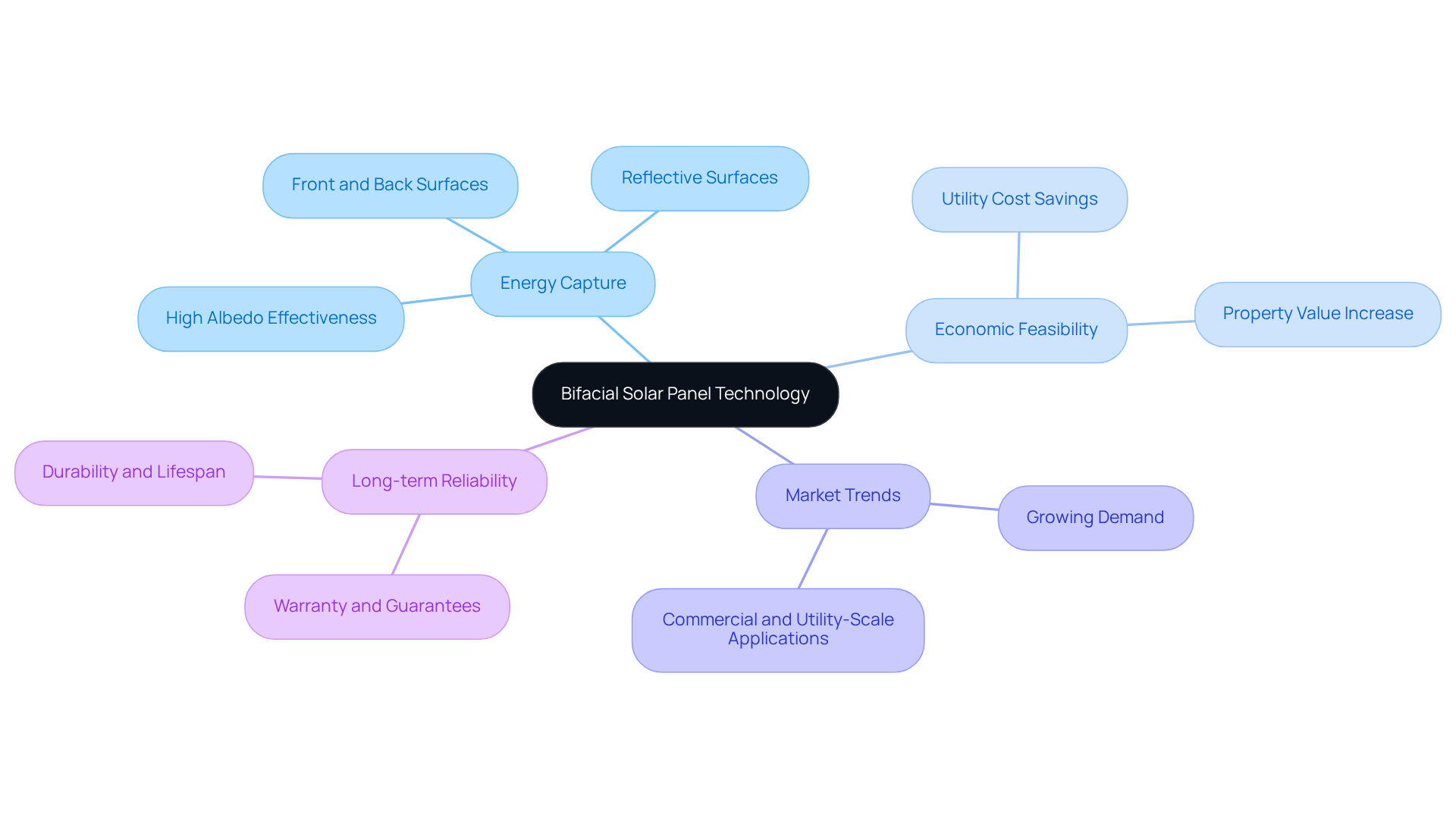
Perovskite Solar Cells: Revolutionizing Manufacturing Efficiency
Perovskite photovoltaic cells represent a transformative advancement in the energy sector, primarily due to their straightforward manufacturing process and impressive efficiency rates. These cells are crafted from low-cost materials and methods, which significantly lowers production costs in comparison to traditional silicon-based cells. Their scalability opens up new avenues for harnessing sunlight, making it increasingly accessible for diverse applications, including residential and commercial projects. Notably, the highest certified power conversion efficiency (PCE) of single-junction perovskite photovoltaic cells has reached an impressive 26.1%, underscoring their competitive edge in power generation.
Ongoing research focused on improving the stability and longevity of perovskite cells is vital for their commercial success. Furthermore, perovskites require less physical space while generating more power than rigid silicon cells, which amplifies their market potential. Successful implementations of perovskite technology in projects across the globe illustrate its capacity to revolutionize power systems, rendering sunlight harnessing more accessible and economically viable for a broader audience.
However, to fully capitalize on the advantages of perovskite photovoltaic cells within the renewable energy sector, challenges such as long-term stability and resilience must be addressed.
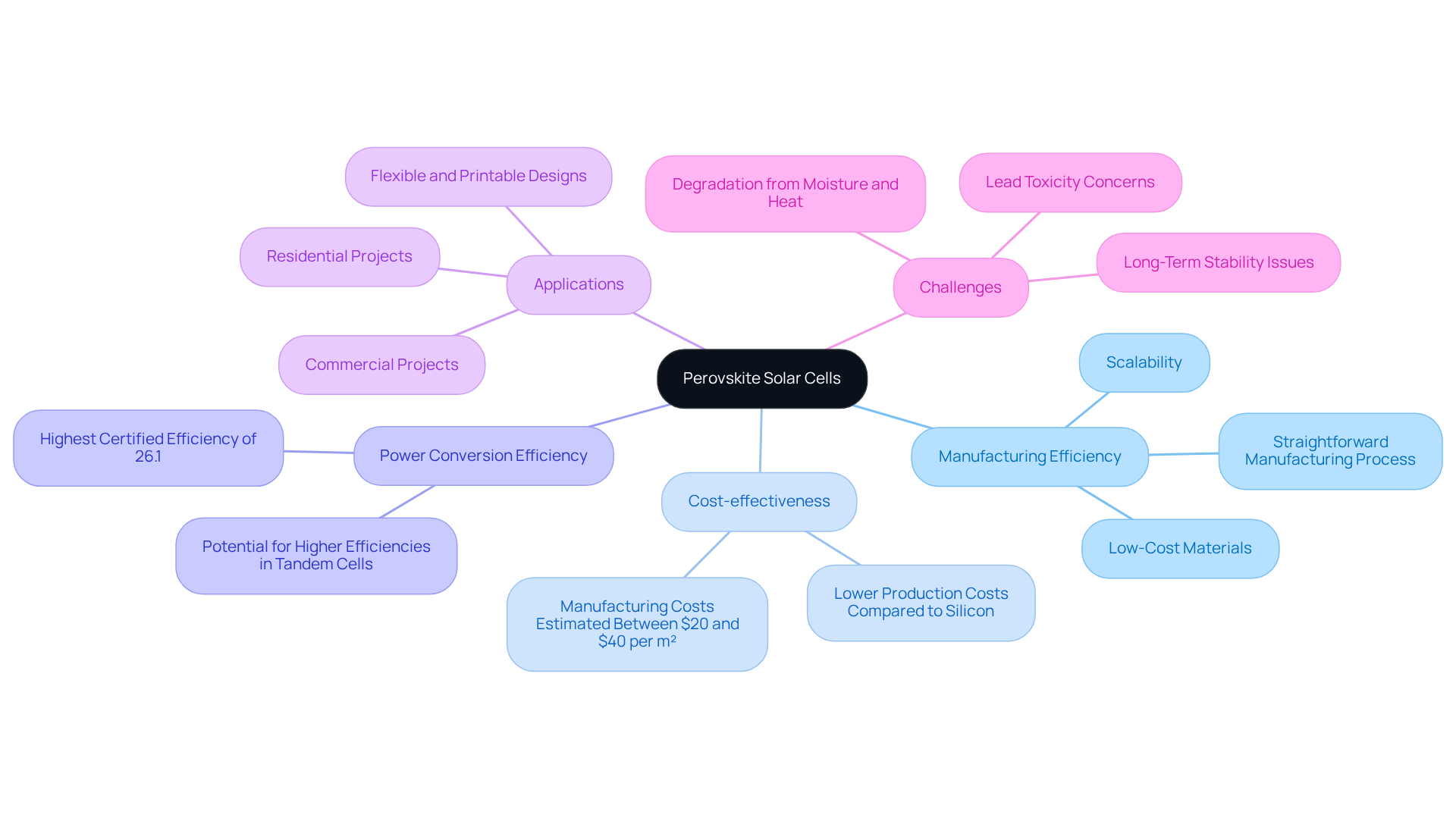
Tandem Solar Cell Designs: Maximizing Efficiency Through Material Innovation
Tandem photovoltaic cell designs represent a significant advancement in solar technology by integrating multiple layers of photovoltaic materials, thereby capturing a broader spectrum of sunlight. Stacking materials such as perovskite atop traditional silicon cells enables these configurations to achieve efficiencies exceeding 30%. Rutuja Borkar highlights this innovation, stating, "While conventional silicon cells are nearing their efficiency limits (~26-27%), tandem cells have achieved over 30% efficiency in laboratory settings." This progress not only enhances power output but also optimizes space efficiency, making tandem photovoltaic cells particularly suitable for metropolitan areas where land is at a premium.
The global market for tandem photovoltaic cells is projected to experience remarkable growth, with an increase from USD 455.47 million in 2024 to USD 9,142.73 million by 2034. This represents a compound annual growth rate (CAGR) of 34.98% from 2025 to 2034. Successful implementations in urban environments, such as the integration of tandem cells into architectural designs, demonstrate the ability of these systems to meet the escalating demand for efficient power solutions. By effectively converting more sunlight into usable energy compared to conventional single-junction silicon cells, tandem photovoltaic cells are positioned to play a crucial role in the transition to renewable energy.
This expansion is driven by the urgent need for more efficient photovoltaic technologies to fulfill global renewable power objectives. As cities continue to grow and the demand for sustainable energy increases, the adoption of tandem photovoltaic cells will be a key factor in addressing these challenges.
![]()
Flexible and Lightweight Solar Panels: Expanding Application Potential
Flexible and lightweight photovoltaic panels are engineered for seamless integration across diverse surfaces, including curved and irregular structures. This adaptability enables power generation in previously unsuitable locations, such as vehicles, portable devices, and building-integrated photovoltaics (BIPV).
The market for lightweight photovoltaic systems is projected to reach USD 1,618.2 million by 2032, reflecting substantial growth driven by increasing demand for sustainable power solutions and innovative architectural designs. Current trends indicate a shift towards the adoption of these panels, with experts underscoring their potential to revolutionize power generation.
Notably, we only need to harness 1/10,000th of the sunlight that reaches the Earth to fully satisfy global power needs, highlighting the importance of lightweight renewable solutions. As the sector evolves, the integration of these innovations is expected to be crucial in enhancing efficiency and expanding access to renewable energy.
However, challenges such as higher initial costs compared to conventional units remain, emphasizing the need for continued innovation and investment in this promising field.
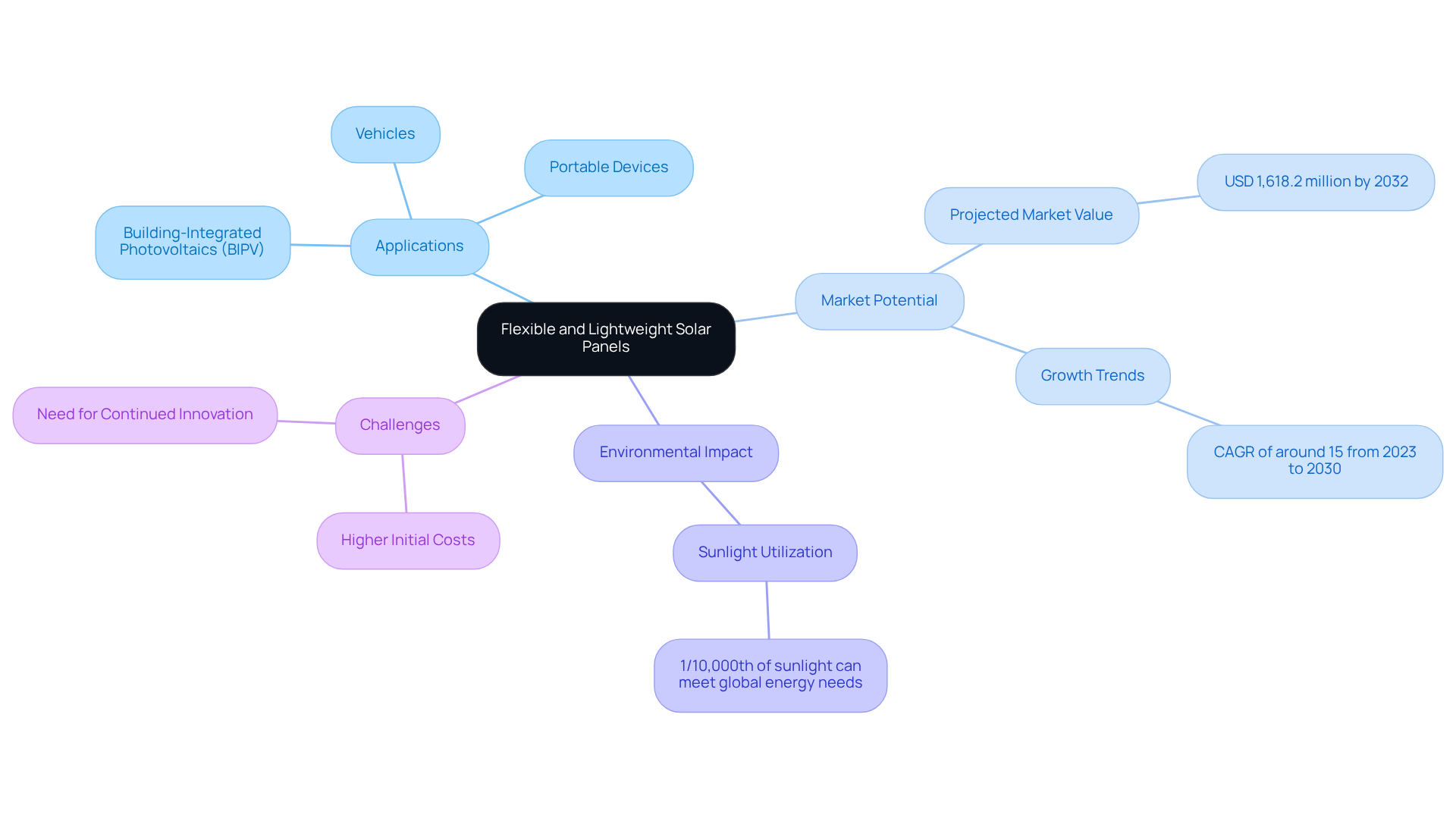
Smart Solar Panels: Unlocking Efficiency and Performance
Intelligent photovoltaic modules, integrated with cutting-edge sensors and IoT technology, are revolutionizing energy output through real-time tracking and enhancement. These innovative surfaces dynamically adjust their angle to capture maximum sunlight, significantly improving efficiency rates. Currently, photovoltaic efficiency stands at 25%, a remarkable leap from the original 1-2% efficiency, showcasing the potential for further advancements in this field. Moreover, these modules seamlessly interact with power management systems, ensuring optimal performance and reliability.
Looking ahead to 2025, the incorporation of IoT technology in photovoltaic panels is expected to increase, with data indicating that smart technology can lead to efficiency enhancements. This integration not only boosts power output but also provides vital information for ongoing maintenance and performance evaluation, paving the way for smarter, more sustainable renewable power solutions.
Ramez Naam emphasizes the critical role of photovoltaic power in meeting rising energy demands and combating climate change, illustrating the transformative potential of IoT in renewable energy sources. Successful implementations, such as the expansion of photovoltaic systems in California, highlight the impact of IoT innovations on renewable power setups. Efficient monitoring and maintenance of photovoltaic panels yield significant ecological benefits, evidenced by the reduction of over 140 million metric tons of CO2 in 2022.
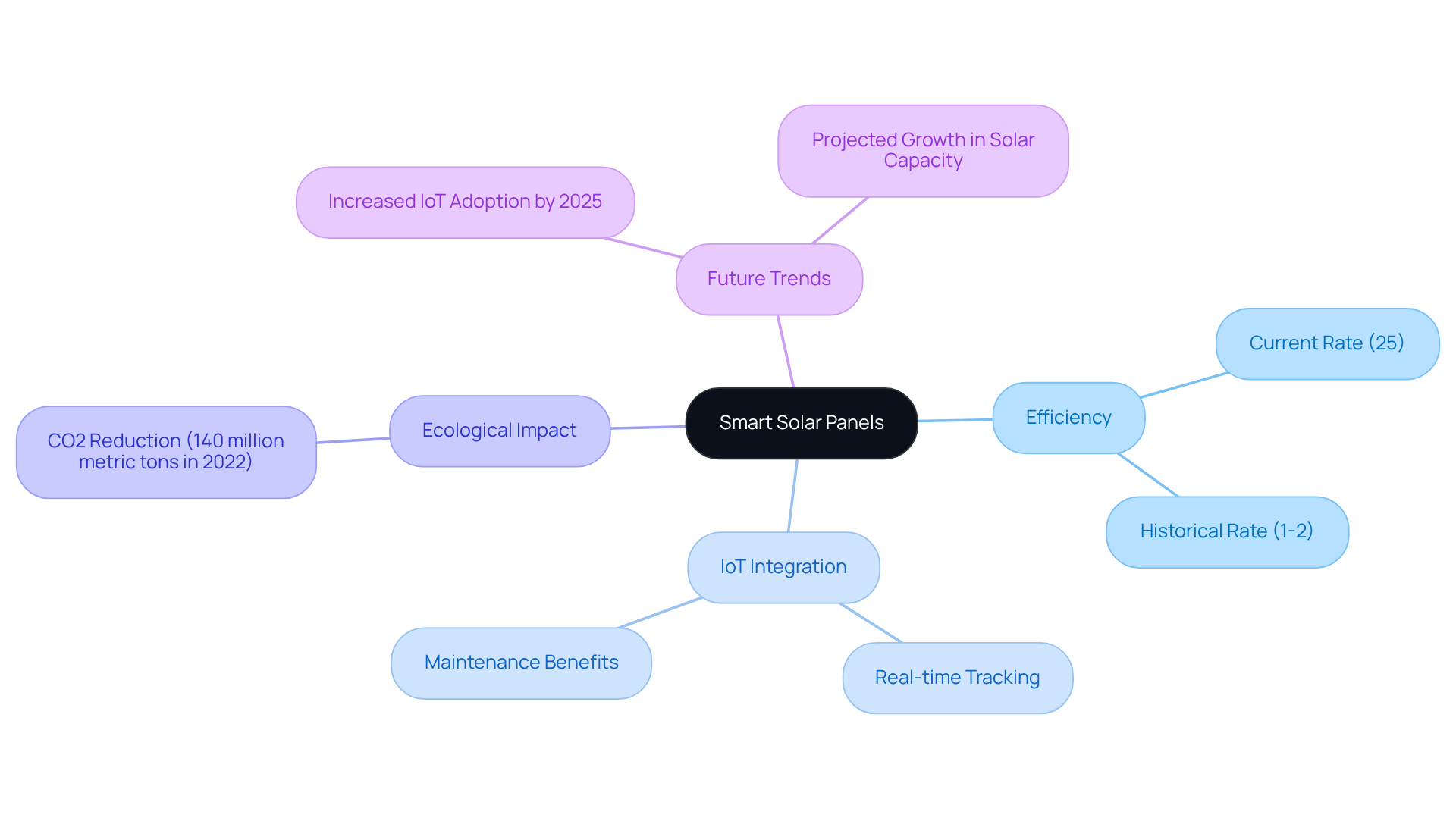
Energy Storage Innovations: Supporting Solar Efficiency
Innovations in power storage, particularly advancements in lithium-ion batteries and the emergence of solid-state technologies, are critical for enhancing the efficiency of photovoltaic systems. These advanced storage solutions capture surplus power generated during peak sunlight hours, which can then be utilized during periods of low production, thereby improving reliability. Notably, lithium-ion battery pack costs have plummeted by 82%, dropping from over $780 per kWh in 2013 to around $139 per kWh in 2023. This dramatic reduction greatly enhances the economic viability of renewable energy initiatives.
Moreover, the incorporation of these batteries enables photovoltaic systems to deliver a steady power supply, significantly increasing their attractiveness to customers and enterprises. By 2025, the successful integration of lithium-ion batteries in photovoltaic projects has resulted in substantial growth in storage capacity. Forecasts suggest that large-scale battery storage will escalate from 1 GW in 2019 to an impressive 98 GW by 2030. Additionally, the total number of operational battery storage systems surged by more than 600%, reaching 325 systems by the end of 2021, underscoring the rapid growth in this sector.
This trend emphasizes the essential role of power storage in transforming sunlight into a reliable and accessible resource, ultimately facilitating the transition to a cleaner energy future. The residential power storage market revenue was valued at USD 6.5 billion in 2024 and is projected to soar to USD 20.8 billion by 2033, further highlighting the economic potential of these advancements.
Furthermore, the impact of the Inflation Reduction Act is expected to boost renewable energy installations by 67% compared to pre-IRA forecasts by 2027, contributing to the momentum of this evolving landscape.
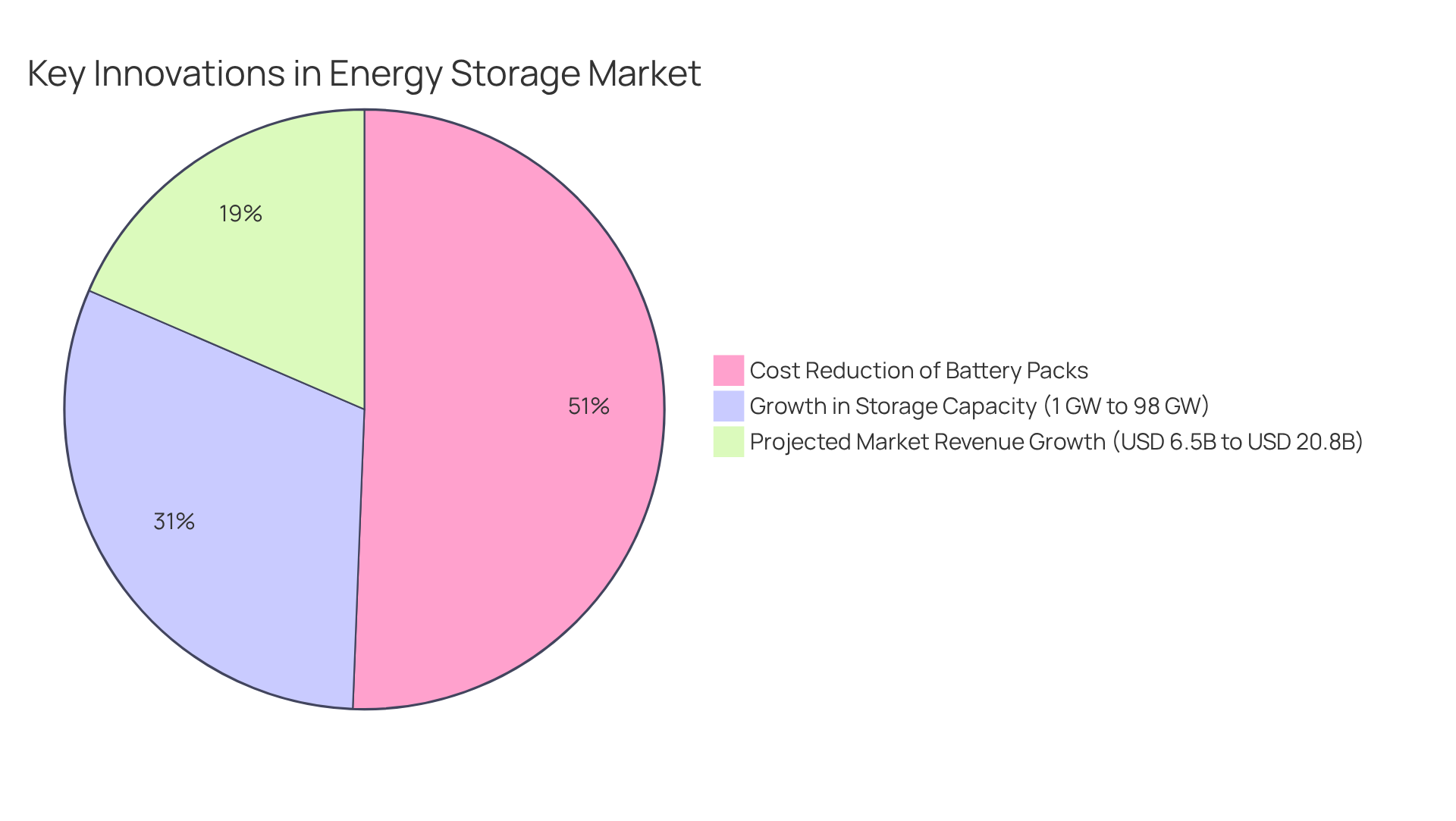
Transparent Solar Panels: Merging Aesthetics with Power
Clear photovoltaic surfaces represent a significant advancement in sustainable power, designed to integrate seamlessly into windows and facades. These panels utilize specialized materials that convert sunlight into electricity while preserving transparency, allowing natural light to illuminate indoor spaces. As urban environments increasingly prioritize sustainability, the appeal of clear photovoltaic solutions grows among architects and developers eager to incorporate renewable resources into their designs without compromising aesthetics.
Recent trends reveal a notable surge in the adoption of clear energy solutions, with the market anticipated to expand considerably by 2025. This growth stems from an escalating demand for energy-efficient buildings and innovative architectural designs that emphasize both functionality and visual allure. Importantly, clear photovoltaic systems not only enhance energy production but also contribute positively to the overall aesthetics of structures, making them an appealing choice for modern architecture.
Successful implementations of transparent energy technology have demonstrated its capacity to reshape urban landscapes. For instance, buildings equipped with these panels have shown improved efficiency and reduced reliance on traditional power sources, underscoring the dual benefits of sustainability and cost-effectiveness. As the sector evolves, the integration of clear energy solutions is expected to revolutionize energy production in urban settings, aligning with broader goals of environmental responsibility and innovative design.
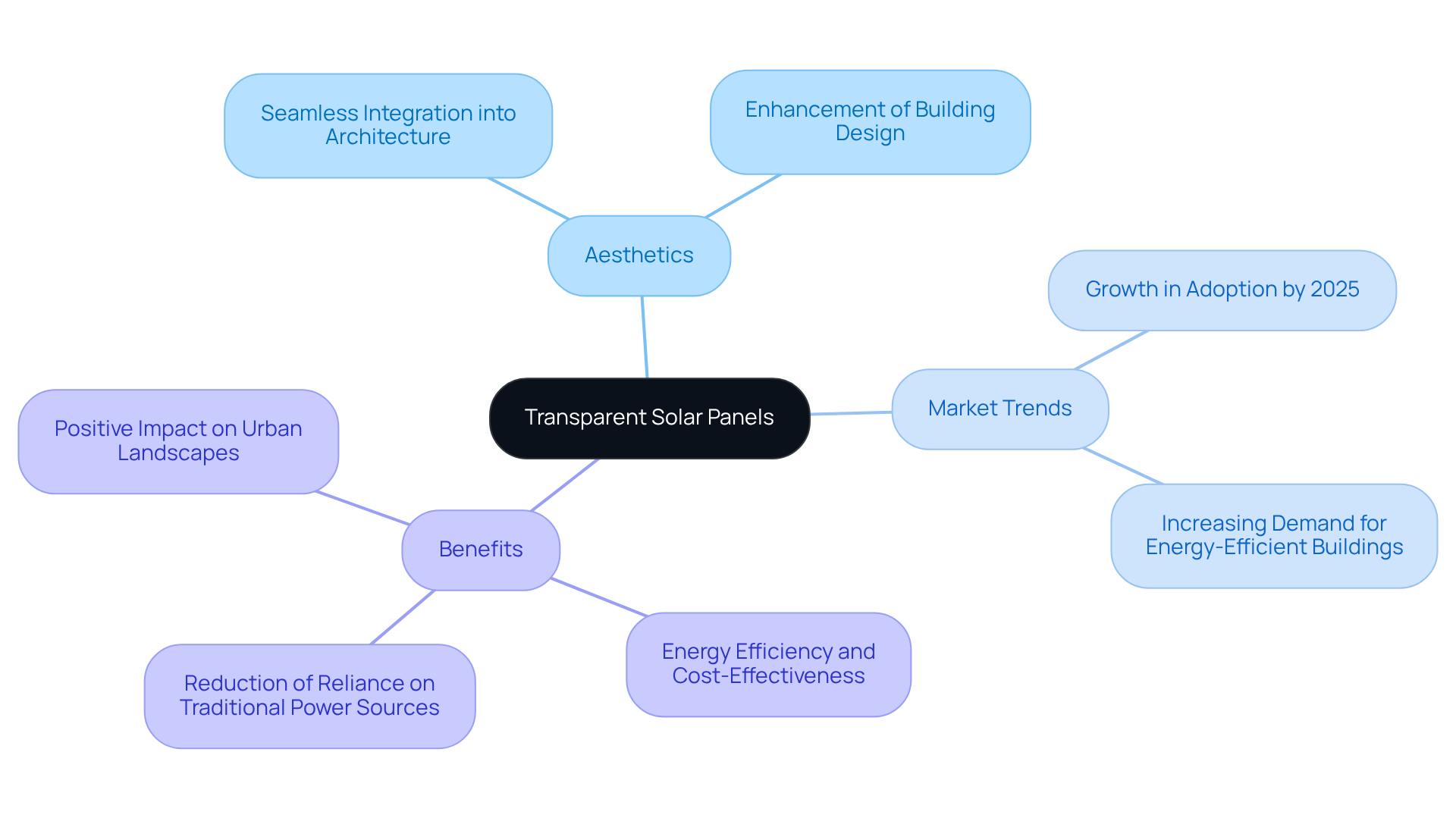
Remaining Challenges in New Solar Technologies: Addressing Limitations
Despite significant advancements in photovoltaic systems, several obstacles persist. High material costs for innovative solutions remain a primary concern, particularly as polysilicon prices have quadrupled over the past year due to supply-demand imbalances. Currently, polysilicon production acts as a bottleneck in the solar PV supply chain, resulting in tight global supplies.
Moreover, the effectiveness of energy conversion requires enhancement, as existing methods often fail to achieve optimal performance. Integrating new technologies into existing infrastructure presents additional challenges, exacerbated by regulatory frameworks that can impede rapid adoption.
In response, the Department of Energy's roadmap, released in early 2025, aims to streamline permitting and interconnection processes, representing a significant initiative to tackle these regulatory hurdles. Market acceptance is also crucial; many energy companies report that customer acquisition poses a substantial barrier to growth, with 31% identifying it as a primary challenge. However, 38% of renewable energy firms anticipate growth in 2025, suggesting potential for overcoming this obstacle.
To ensure the ongoing growth and success of renewable energy solutions, it is essential to address these limitations through strategic investments in research and development, alongside fostering public-private collaborations that can catalyze innovation and enhance market conditions.
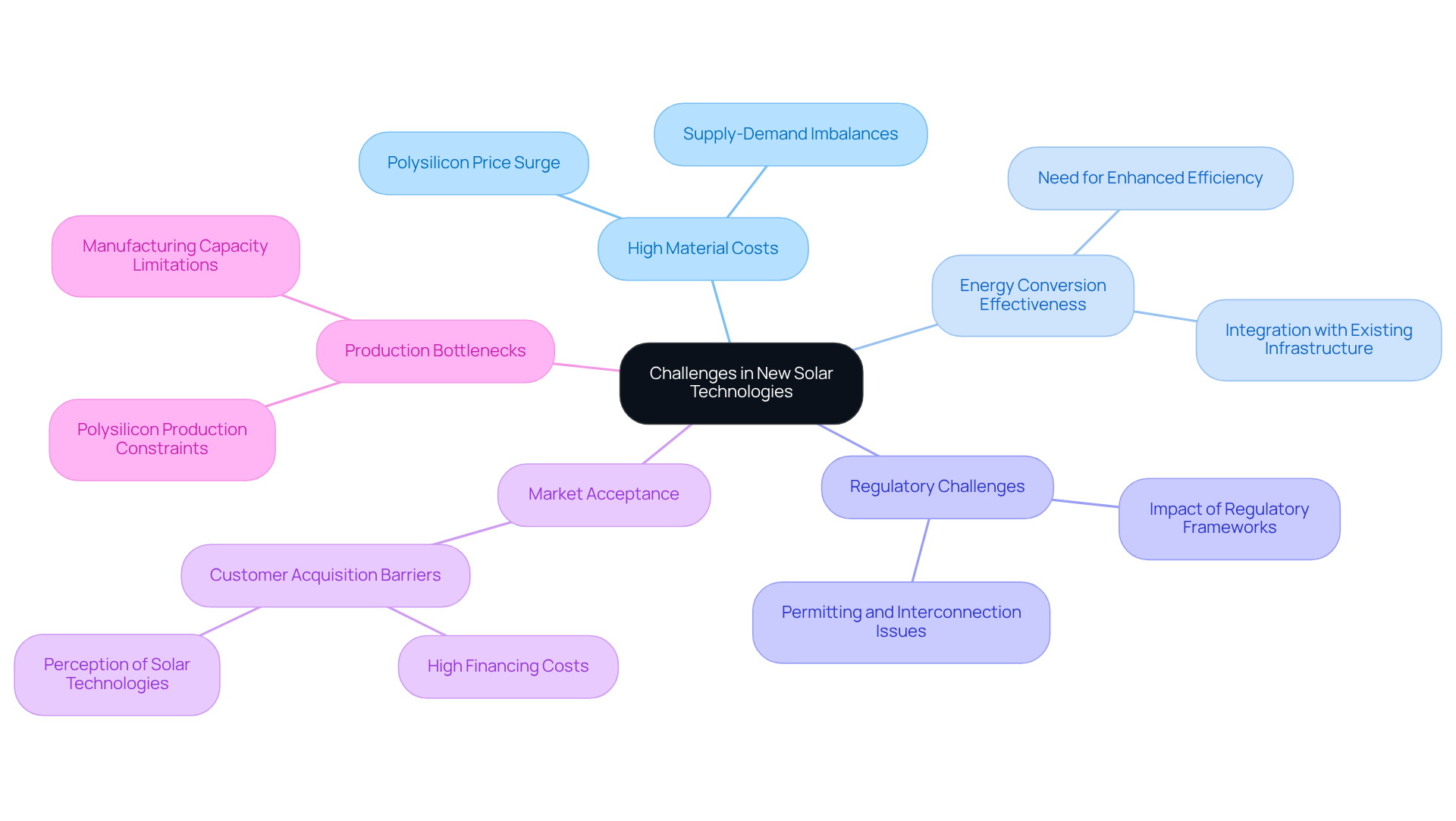
Future Trends in Solar Panel Technology: Insights for 2025 and Beyond
As we approach 2025, the photovoltaic industry stands on the brink of significant transformations, driven by key trends. The advancement of sophisticated materials is enhancing the efficiency of photovoltaic systems, with some units achieving conversion efficiencies exceeding 25%. The integration of AI and machine learning is revolutionizing performance optimization, enabling real-time monitoring and predictive analytics to maximize energy output. Intelligent photovoltaic modules equipped with IoT capabilities, including sensors and automation, are expected to greatly enhance system reliability and efficiency.
In urban environments, the rise of renewable energy applications is becoming increasingly vital. Innovations such as clear photovoltaic panels and dual-sided technology facilitate power generation without compromising aesthetics or space. These advancements are particularly relevant as sustainability becomes a priority for both consumers and businesses, driving demand for innovative energy solutions that align with environmental goals.
Statistics indicate that by 2025, residential installation rates are projected to rise from 14% in 2023 to a record 25%, reflecting a growing acceptance of renewable resources. Furthermore, the global market for AI integration in renewable power systems is anticipated to expand significantly, with forecasts suggesting an increase in battery storage capacity and overall market growth. As the industry evolves, the synergy of cutting-edge technology and sustainable practices, bolstered by government policies, will be pivotal in shaping the future of solar energy, with solar expected to contribute 45% of U.S. electricity supply by 2030.
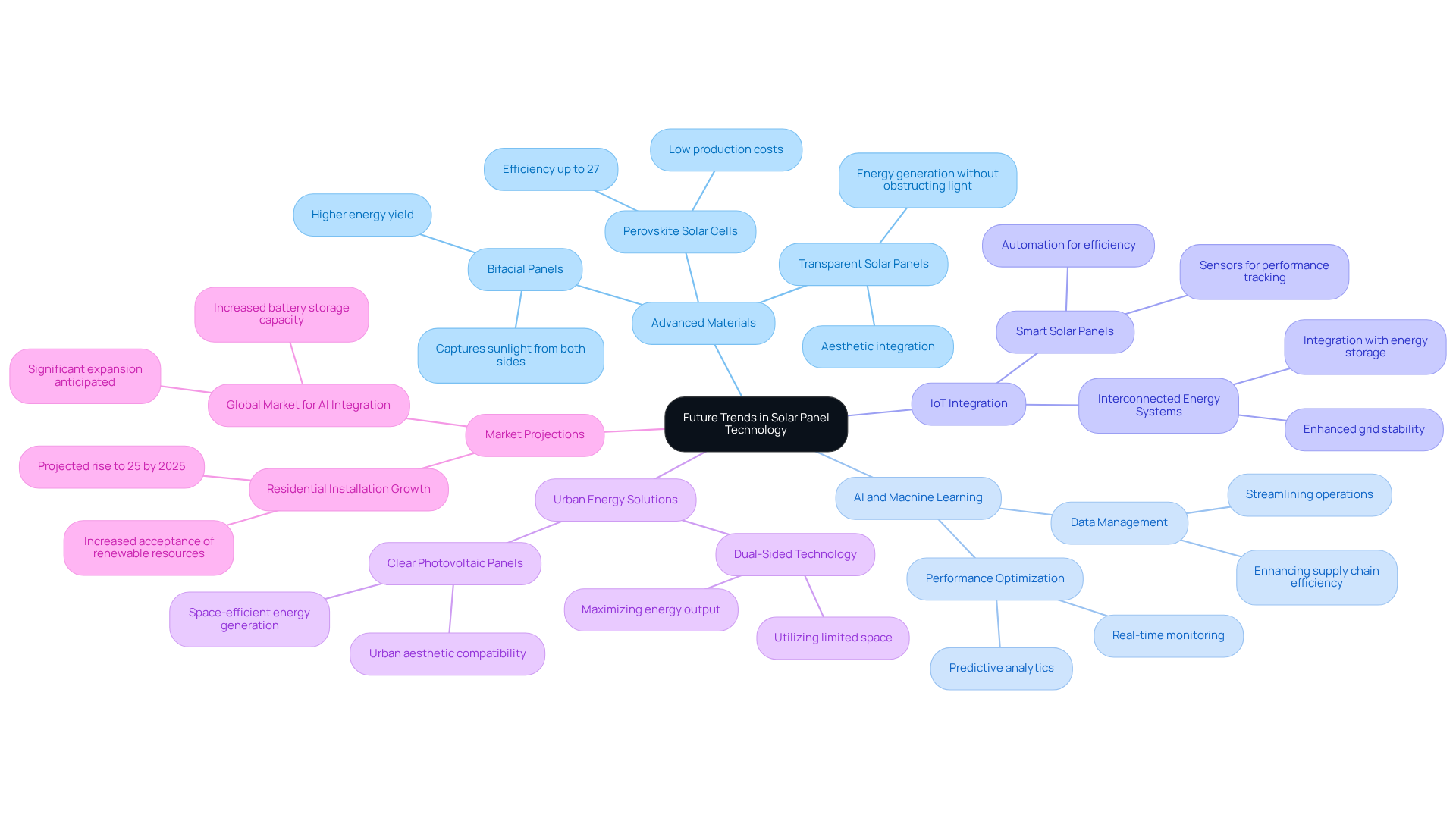
Conclusion
The advancements in solar technology highlighted in this article signify a transformative shift towards more efficient and sustainable energy solutions. Innovations such as bifacial solar panels, perovskite cells, and smart solar technologies are emerging, revealing the potential for enhanced energy capture and reduced costs. The integration of these technologies not only addresses the growing demand for clean energy but also positions the solar industry as a pivotal player in the global transition towards sustainability.
Key insights from the discussion underscore the importance of innovative designs and materials, including:
- Tandem solar cells
- Flexible panels
These maximize efficiency and broaden application potential. Additionally, the role of energy storage innovations is crucial, as they ensure reliability and optimize the use of renewable resources. As the industry navigates challenges like material costs and regulatory hurdles, strategic investments in research and development will be essential for overcoming these obstacles and fostering growth.
In conclusion, the future of solar energy appears promising, with significant advancements poised to reshape the landscape of power generation. Embracing these innovations will not only contribute to a cleaner environment but also drive economic growth and energy independence. As stakeholders in the energy sector, it is imperative to support and invest in these emerging technologies, ensuring that the potential of solar energy is fully realized for a sustainable future.
Frequently Asked Questions
What services does Harbinger Land provide for energy and infrastructure projects?
Harbinger Land offers comprehensive land service solutions including site and right-of-way acquisition, title research, GIS mapping, and advanced data processing.
How does Harbinger Land enhance operational efficiency?
Harbinger Land utilizes cutting-edge technology such as AI-powered title research software and integrated GIS modeling services to streamline processes and improve client satisfaction.
What types of clients does Harbinger Land serve?
Harbinger Land serves a diverse clientele that includes natural gas firms, renewable energy developers, and municipalities.
When was Harbinger Land established?
Harbinger Land was established in 2012.
What are bifacial solar panels and how do they work?
Bifacial solar panels are designed to capture sunlight from both the front and back surfaces, utilizing reflective surfaces beneath them to enhance light absorption, particularly in high albedo environments.
What are the benefits of using bifacial solar panels?
Bifacial solar panels can achieve output yields exceeding conventional monofacial units by up to 45% under optimal conditions, leading to long-term savings on utility costs and potential increases in property value.
What is the expected market trend for bifacial photovoltaic technology?
The market for bifacial photovoltaic technology is expected to expand in 2025, with successful implementations in commercial and utility-scale contexts.
What are perovskite solar cells and why are they significant?
Perovskite solar cells are a type of photovoltaic technology known for their straightforward manufacturing process, low production costs, and impressive efficiency rates, with a maximum certified power conversion efficiency of 26.1%.
What are the advantages of perovskite solar cells over traditional silicon-based cells?
Perovskite cells require less physical space while generating more power and are cheaper to produce, making them more accessible for various applications.
What challenges must be addressed for the commercial success of perovskite solar cells?
Ongoing research is needed to improve the stability and longevity of perovskite cells to fully capitalize on their advantages in the renewable energy sector.
List of Sources
- Harbinger Land | Comprehensive Solutions for Land Services in Energy and Infrastructure
- Clean Power Facts | ACP (https://cleanpower.org/facts)
- Land Leasing in the US - Market Research Report (2015-2030) (https://ibisworld.com/united-states/industry/land-leasing/1352)
- 60 Quotes About the Future of Renewable Energy (https://deliberatedirections.com/renewable-energy-quotes)
- 20 Quotes To Get You Inspired For a Renewable Future - Solstice (https://solstice.us/solstice-blog/20-quotes-for-a-renewable-future)
- How Much Land Is Needed for 100% Renewable Energy? (Latest Research Stats) (https://patentpc.com/blog/how-much-land-is-needed-for-100-renewable-energy-latest-research-stats)
- Bifacial Solar Panel Technology: Enhancing Energy Capture
- 7 Easy Ways To Improve Your Property’s EPC Rating (https://theecoexperts.co.uk/solar-panels/bifacial-solar-panels)
- Bifacial Solar Panels: A Comprehensive Guide for 2023 (https://sungoldsolar.com/bifacial-solar-panels-2023)
- Bifacial Solar Panels: What You Need to Know (https://energysage.com/solar/bifacial-solar-panels-what-you-need-to-know)
- A Guide To Bifacial Solar Panels | Synergy Renewable Energy (https://synergy-renewables.co.uk/news/bifacial-solar-panels)
- Top Ten Quotes about Solar Power (https://harnessoursun.com/top-ten-quotes-about-solar-power)
- Perovskite Solar Cells: Revolutionizing Manufacturing Efficiency
- Achievements, challenges, and future prospects for industrialization of perovskite solar cells - Light: Science & Applications (https://nature.com/articles/s41377-024-01461-x)
- The levelized cost of electricity from perovskite photovoltaics - PMC (https://pmc.ncbi.nlm.nih.gov/articles/PMC9932852)
- A Revolution in Solar Power - Perovskite Solar Cells - The Renewable Energy Institute (https://renewableinstitute.org/a-revolution-in-solar-power-perovskite-solar-cells)
- Materials and methods for cost-effective fabrication of perovskite photovoltaic devices - Communications Materials (https://nature.com/articles/s43246-024-00636-8)
- Quotes About Solar Power: 50 Picks to Light Up Your Life - Lumify Energy (https://lumifyenergy.com/blog/quotes-about-solar-power)
- Tandem Solar Cell Designs: Maximizing Efficiency Through Material Innovation
- Breakthrough Method Achieves 28.2% Efficiency in Tandem Solar Cells (https://list.solar/news/breakthrough-20)
- Tandem solar cells reach 30 percent efficiency (https://innovationorigins.com/en/selected/tandem-solar-cells-reach-30-percent-efficiency)
- Tandem Solar Cells: A New Era of High-Efficiency Solar Power (https://energymatters.com.au/renewable-news/tandem-solar-cells-a-new-era-of-high-efficiency-solar-power)
- Tandem Solar Cell Market Set to Soar to USD 9.14 Billion by 2034, Through 34.98% CAGR Forecast (https://linkedin.com/pulse/tandem-solar-cell-market-rutuja-borkar-lmdsf)
- Recent Progress in Perovskite Tandem Solar Cells (https://mdpi.com/2079-4991/13/12/1886)
- Flexible and Lightweight Solar Panels: Expanding Application Potential
- Flexible Solar Panels Market 2025: Industry Size, Regions, Emerging Trends, Growth Insights, Opportunities, and Forecast By 2033 (https://marketstatsville.com/flexible-solar-panels-market)
- Flexible Solar Panels Market Size to Reach USD 1,618.2 Million by 2032 (https://acumenresearchandconsulting.com/press-releases/flexible-solar-panels-market)
- Quotes About Solar Power: 50 Picks to Light Up Your Life - Lumify Energy (https://lumifyenergy.com/blog/quotes-about-solar-power)
- Global Flexible Solar Panels Market Research and Development Focus 2025-2032 (https://statsndata.org/report/flexible-solar-panels-market-6066)
- Smart Solar Panels: Unlocking Efficiency and Performance
- Top Ten Quotes about Solar Power (https://harnessoursun.com/top-ten-quotes-about-solar-power)
- 90+ Solar Energy Statistics: The Green Gold Rush (2025) - Enkonn Solar (https://enkonnsolar.com/solar-energy-statistics)
- Quotes About Solar Power: 50 Picks to Light Up Your Life - Lumify Energy (https://lumifyenergy.com/blog/quotes-about-solar-power)
- Solar Panel Statistics, Facts, and Trends of 2025 (https://greenmatch.co.uk/solar-energy/solar-pv-statistics)
- Solar - IEA (https://iea.org/energy-system/renewables/solar-pv)
- Energy Storage Innovations: Supporting Solar Efficiency
- The Top 10 Quotes on Energy So Far in 2013 (https://greentechmedia.com/articles/read/the-top-10-quotes-on-energy-so-far-in-2013)
- Residential Solar Energy Storage Market: Key Stats & Trends, And Impact of AI (https://linkedin.com/pulse/residential-solar-energy-storage-market-key-stats-hqduf)
- Clean Energy Storage Facts | ACP (https://cleanpower.org/facts/clean-energy-storage)
- Solar Industry Research Data – SEIA (https://seia.org/research-resources/solar-industry-research-data)
- Empowering the Future: The Most Inspirational Quotes About Battery Energy Storage (https://eszoneo.com/info-detail/empowering-the-future-the-most-inspirational-quotes-about-battery-energy-storage)
- Transparent Solar Panels: Merging Aesthetics with Power
- 60 Quotes About the Future of Renewable Energy (https://deliberatedirections.com/renewable-energy-quotes)
- Quotes About Solar Power: 50 Picks to Light Up Your Life - Lumify Energy (https://lumifyenergy.com/blog/quotes-about-solar-power)
- 10 Quotes Concerning Energy Transformation from the ARPA-E Summit (https://powermag.com/10-quotes-concerning-energy-transformation-from-the-arpa-e-summit)
- Danish researchers help set world record: Transparent solar cells could turn future buildings into power plants (https://sdu.dk/en/forskning/sdu-climate-cluster/news/solcellevinduer-kan-goere-fremtidens-bygninger-til-kraftvaerker)
- Remaining Challenges in New Solar Technologies: Addressing Limitations
- 60 Quotes About the Future of Renewable Energy (https://deliberatedirections.com/renewable-energy-quotes)
- 2025 Solar Energy Statistics: Latest Industry Survey Data (https://solarreviews.com/blog/solarreviews-solar-industry-survey-key-statistics)
- Solar Market Insight Report – SEIA (https://seia.org/research-resources/us-solar-market-insight)
- TOP 25 SOLAR ENERGY QUOTES | A-Z Quotes (https://azquotes.com/quotes/topics/solar-energy.html)
- Executive summary – Solar PV Global Supply Chains – Analysis - IEA (https://iea.org/reports/solar-pv-global-supply-chains/executive-summary)
- Future Trends in Solar Panel Technology: Insights for 2025 and Beyond
- 10 key trends and statistics shaping the solar power industry in 2025 (https://powercor.co.uk/key-trends-shaping-solar-power-in-2025)
- 7 New Solar Panel Technology Trends Shaping the Future (https://greenlancer.com/post/solar-panel-technology-trends)
- 2025 Renewable Energy Industry Outlook (https://deloitte.com/us/en/insights/industry/renewable-energy/renewable-energy-industry-outlook.html)
- Solar Panel Statistics, Facts, and Trends of 2025 (https://greenmatch.co.uk/solar-energy/solar-pv-statistics)
- 90+ Solar Energy Statistics: The Green Gold Rush (2025) - Enkonn Solar (https://enkonnsolar.com/solar-energy-statistics)




